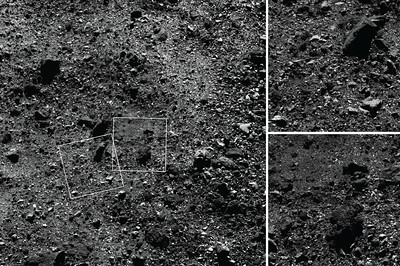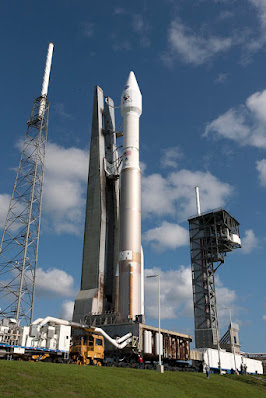The NASA spacecraft OSIRIS REX which delivers samples from the Bennu Asteroid has changed its course and is returning to the earth.
 |
Space Asteroid GIF By NASA |
SYNOPSIS
The OSIRIS REX spacecraft used its thrusters for a brief period on September 21, 2022, to alter its path and return to Earth. The Bennu Asteroid has a 0.037 percent (or 1 in 2,700) chance of colliding with the Earth. Researchers expect to discover more about the solar system's building blocks and perhaps even about the components of life itself. Asteroid Bennu (1999 RQ36) is now 266,108,646 kilometers (1.778826 astronomical units) away from Earth. Bennu is an old remnant from the early solar system that has lived through more than 4.5 billion years of history.
The strongest evidence indicates that Bennu's present-day chemistry and mineralogy were already formed within 10 million years of the birth of our solar system. Bennu was found on September 11, 1999, by the Lincoln Near-Earth Asteroid Research during a near-Earth asteroid survey (LINEAR). In May 2021, OSIRIS-REx departed Bennu to start its arduous return trip to Earth. It will release the capsule containing Bennu material into Earth's atmosphere in September 2023. The capsule will drop into the Utah desert and land there.
After colliding with the Bennu Asteroid in October 2020, the OSIRIS REX mission will reach Earth the following year. From the solar system, it returns 250 grams of prehistoric material. Because of the valuable cargo, it is carrying—samples from the Bennu asteroid obtained in 2020 and returned to Earth the following year—the American NASA Osiris Rex spacecraft altered its course to Earth.
 |
| "NASA Begins Launch Preparations for the First U.S. Asteroid Sampling Mission" by NASA's Marshall Space Flight Center is licensed under CC BY-NC 2.0. |
A third of a mile, or almost half a kilometer, is how broad the Bennu Asteroid is. Even if it wouldn't be quite big enough to wipe out the entire world, it might still produce a huge area of destruction. According to classification standards, the Bennu Asteroid is a potentially hazardous object. It has a 0.037 percent (or 1 in 2,700) chance of colliding with the Earth.
 |
| "BENNU’S JOURNEY Poster" by NASA Goddard Photo and Video is licensed under CC BY 2.0. |
The material that makes up asteroids was left behind when the early solar system and its planets, including Earth, formed. On September 24, 2023, when OSIRIS-REx returns its rock and dust samples, researchers expect to discover more about the solar system's building blocks and perhaps even about the components of life itself. According to NASA, the OSIRIS-REx sample return mission has been entrusted with accomplishing a task that is far from a straightforward "package delivery." OSIRIS-REx is officially called Origins, Spectral Interpretation, Resource Identification, and Security-Regolith Explorer.
 |
| "A Region of Bennu’s Northern Hemisphere Close Up" by NASA's Marshall Space Flight Center is licensed under CC BY-NC 2.0. |
The 135-mile giant asteroid Eugenia has a moon dubbed Petit-Prince circling it that is 8 miles wide. This discovery was made in 1999. The existence of the nine-mile-wide moon Pulcova, which orbits the 90-mile-wide asteroid Pulcova, was discovered in 2000. Bennu is an old remnant from the early solar system that has lived through more than 4.5 billion years of history.
The strongest evidence indicates that Bennu's present-day chemistry and mineralogy were already formed within 10 million years of the birth of our solar system. 101955 The semi-major axis of the Bennu Discovery is 1.1264 au (168.51 Gm). Entitlement 0.20375 Sidereal orbital period: 1.1955 years (436.65 days); average orbital speed: 28.0 km/s (63,000 mph). Asteroid 101955 Bennu (1999 RQ36) is now 266,108,646 kilometers (1.778826 astronomical units) away from Earth. Light travels from the asteroid 101955 Bennu (1999 RQ36) to Earth in 14 minutes and 47.6429 seconds.
 |
| "KSC-20160907-PH_KLS01_0150" by NASAKennedy is licensed under CC BY-NC-ND 2.0. |
It bears the name Bennu, from the legendary bird of the Sun, creation, and rebirth in ancient Egypt. With a mean diameter of 490 m (1,610 ft; 0.30 mi), 1019555 Bennu has been closely monitored by the Goldstone Deep Space Network and the planetary radar at Arecibo Observatory. Lockheed Martin developed and constructed NASA's OSIRIS-REx, which set off toward Bennu on September 8, 2016. The University of Arizona is in charge of OSIRIS-REx's team, while the Goddard Space Flight Center of NASA is in charge of the mission's administration. According to Sandy Freund, OSIRIS-REx mission operations manager for Lockheed Martin, which developed the spacecraft, "the performance of the spacecraft was fantastic." A successful touchdown, a puff of stony debris, and a clean exit from the asteroid Bennu were all seen by OSIRIS-REx.
 |
| "OSIRIS-REx Approaches Asteroid Bennu" by NASA Goddard Photo and Video is licensed under CC BY 2.0. |
 |
| "NASA's OSIRIS-REx Spacecraft Arrives at Asteroid Bennu" by NASA's Marshall Space Flight Center is licensed under CC BY-NC 2.0. |
To successfully release the capsule with the Bennu sample into the planet's atmosphere, the spaceship must approach Earth at a specific speed and in the proper direction. "The capsule will jump out of the atmosphere if the angle is too high." If the angle is too low, it will burn up in the atmosphere of Earth.
To assure the success of the seven-year mission, which was launched on September 8, 2016, and landed at Bennu on October 20, 2020, further course adjustments like this will be necessary during the coming year. In July 2023, OSIRIS-REx will start a series of steering maneuvers because, if it continued on its present course, the spacecraft would pass Earth at a distance of around 2,200 kilometers. "We will progressively change OSIRIS-trajectory REx's over the coming year to bring the spacecraft closer to Earth." "When the Earth is at that location, we must pass through its orbit," he continued by adding.
The recovered cargo will then be transported by NASA personnel to a recently constructed, specifically designed preservation facility at the Johnson Space Center in Houston. The sample will be preserved as closely as feasible to how it was when OSIRIS-REx obtained it via the use of instruments, storage containers, and specialized glove boxes that are all designed to avoid contamination. A sizable sample will be saved for future generations to study, and the mission will also send samples to scientific teams all across the world.
"SPACE DEFENDER"
 |
| Arcade Shooting |
"Alien armies are attacking our solar system. With our sophisticated black matter asteroid guidance system, we must protect the planets. Asteroids that can be sent into space are created by this technology. You have been selected as the launch controller to save our solar system from annihilation."
Not all of Bennu's discoveries from the OSIRIS-REx mission, though, have to wait for the sample. Even before the spacecraft arrives on Earth next year, it has sent back information that might help scientists learn more about the asteroid. According to experts, if OSIRIS-REx had attempted to land on it instead of firing its thrusters to immediately recoil, it would have fallen below its surface. This is according to data obtained by the spacecraft on its surface in July.
Additionally, OSIRIS-REx has given NASA information that is crucial for determining the possible threat's orbit up to the year 2300. This information may be essential in assessing whether Bennu, which has a diameter of 490 meters, will pass near Earth in 2135 and whether it will strike the planet. According to Kelly Fast, manager of NASA's Observations Program, "NASA's Planetary Defense goal is to identify and monitor asteroids and comets that may approach Earth and represent a threat to our planet." NASA's Near Earth Objects.
As part of this endeavor, NASA conducts continual astronomical surveys that gather data to find new objects and improve our orbital models for them. Researchers now have an exceptional chance to improve and test these models thanks to the OSIRIS-REx mission, which will enable us to more accurately forecast Bennu's location when he comes within more than a century of Earth.
Despite the mission's success, NASA was having problems because the Osiris-Rex spacecraft lost the asteroid material it had recovered. The asteroid Bennu, which is 320 million miles from Earth, was sampled by the probe last Tuesday, but the sample compartment's doors were unable to be closed.
The crew will try to insert the sample container inside the return capsule these days—much sooner than initially planned—because specialists say there is nothing the flight controllers can do to remove the obstacles and stop further Bennu bits from escaping. The goal of scientists is to reduce losses at the rate of particle escape. Time is of the essence to prevent future losses, according to Thomas Zurbuchen, director of NASA's scientific missions, who is now working to reduce the device's operations and hasten the preparation of sample storage in a container aboard the probe.
 |
| "NASA’s OSIRIS-REx Unlocks More Secrets from Asteroid Bennu" by NASA's Marshall Space Flight Center is licensed under CC BY-NC 2.0. |
The expert estimated that the ship would have brought in roughly 400 grams of debris, far more than the minimum of 60 grams that was originally required. But because of the microgravity condition, which causes the pieces to act like fluids, between 5 and 10 grams were already seen surrounding the collecting arm in a more or less dense cloud.
CONCLUSION
The Bennu Asteroid is a potentially hazardous object. It has a 0.037 percent (or 1 in 2,700) chance of colliding with the Earth. Bennu is an old remnant from the early solar system that has lived through more than 4.5 billion years. Bennu was found on September 11, 1999, by the Lincoln Near-Earth Asteroid Research. It has a cumulative 1-in-1,800 probability of hitting Earth, with September 24, 2182, having the highest danger.
OSIRIS-REx set off toward Bennu on September 8, 2016. In May 2021, OSIRIS-REx departed Bennu to start its arduous return trip to Earth. The Sample Return Capsule will pass through the Earth's atmosphere at a peak speed of 27,700 mph. The capsule will drop into the Utah desert and land there.


.gif)





0 Comments
Please do not enter spam links in the comment box.